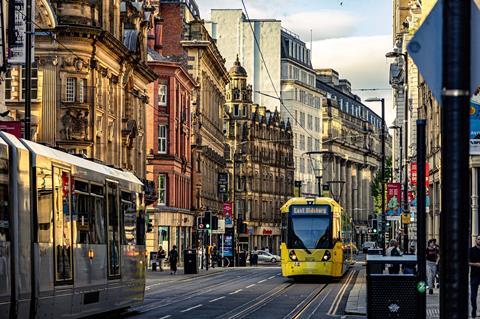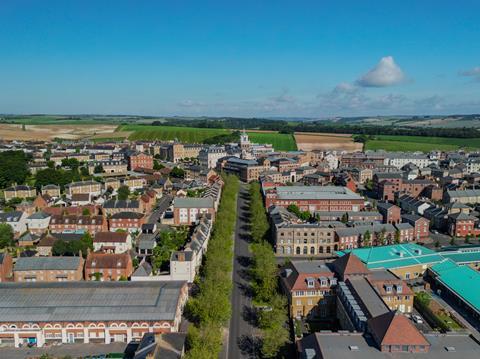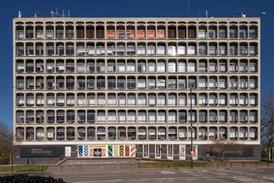Nicholas Boys Smith celebrates the strengths and examines the flaws of the new towns task force’s recommendations and site list

Three public engagement events; 11 task force members; 12 new towns; 15 months; 44 policy recommendations; 54 stakeholders; 55 years since a new town was designated; 119 pages… The new towns taskforce’s report to government has finally been published. Is it any good?
Put differently: will it create more homes fast enough? Will these new homes be in places which boost prosperity and economic growth and alleviate housing shortages?
And will any new towns support happiness, health and neighbourliness? Will they, in short, be good places? Will they make Britain better?
I should declare an interest. Create Streets is a town-building and specialist think-tank. We have a point of view on this subject and drafted the very first public report, for the Labour Party when in opposition, which led to the new towns programme.
I would argue that it is a serious report, seriously and thoughtfully written. It deserves a serious response and it is, in my judgment, overall to be welcomed. I believe it will lead to activity which is materially helpful, to meeting our disastrous housing shortfall. (Brownfield passports to legitimise the intensification of existing streets is the crucial short term weapon which perversely and disappointingly the government has not ‘fired’). The report has at least five key strengths, two important limitations and one potentially fatal flaw. Here they are, starting with the strengths.
Firstly, the report understands the problem. From as early as the second paragraph, it is clear that proposed programme is based on a correct understanding of the cascading and disastrous consequences of our housing shortfall not just for disposable income and living standards but also for labour market flexibility, family formation and economic growth.
This may sound like damning with faint praise, but it really isn’t. Given the total tosh that still passes for responsible analysis in some newspapers (denying that undersupply of homes matters) or continues to be espoused by some politicians (boosting demand in a supply constrained market) we should always cheer when government policy is based on rational realism.
Secondly, thanks to its placemaking principle and approach to delivery, this is for the most part a programme for town-building not for housebuilding. This is not a semantic distinction. Towns ‘come together’. They can boost productivity and economic serendipity, as Edward Glaeser and many others have demonstrated. Spatial economists are increasingly clear that Britain’s lack of gently dense towns supported by public transport undermines Britain’s productivity. The programme recognises that we need to create places with real middles, walkable streets, public transport and a mingling of uses. Recommendations four and five are particularly important in ensuring this. They call for:
‘A well-designed and distinctive place, supported by a town-wide strategic masterplan and design code to ensure placemaking quality…. at a density sufficient to enable residents to walk to local amenities, support public transport, unlock better social infrastructure, and create active and liveable neighbourhoods, with government establishing clear minimum density thresholds.’
It is worth adding that the intellectual ascendancy of the ‘new urbanism’ movement is near total in this report. Despite its political nods to the importance of the post war new towns, which failed more often than they succeed, and whether all its authors appreciate it or not, the report sums to a profound rejection of the dogma of sprawling traffic modernism which dominated development for the post-war generations. It understands the links between place with human outcomes.
‘Trains’ or ‘railways’ are mentioned 48 times, ‘trams’ nine times, ‘busses’ eight times, ‘roads’ 16 times and ‘cars’ only seven times, six of them negative and five with the word ‘dependent’ or ‘dependency’ adjoined. This report is not, at least in intention, a recipe for drive-to-boxes in looped cul-de-sacs dropped carelessly into the next field. This is in sharp contrast to a generation of ‘garden villages’ and ‘ecotowns’ which were conceptually flawed from the start, greenwashed housing estates rolling carelessly and expensively over the countryside.

Thirdly, the specific sites are, largely, tactically well chosen. Collectively, they make use of existing infrastructure, nestle into existing towns and encourage investment into existing places which need restitching and more love. The sites which will probably be the most viable are Thamesmead, Enfield, Milton Keynes and Tempsford. There is clear support for urban extensions and intensifications to existing towns which, as Create Streets has shown in Wiltshire and in Cambridge, makes for more viable and sustainable development patterns.
Fourth, the report worries about risk. Due to the disastrously unpredictable, complex and process-heavy nature of the British planning system, development is almost uniquely risky and difficult in the UK. More widely the government is not yet doing enough to fix this. However, the approach for new towns is reassuring. The proposed use of development corporations and an awareness of existing, though little used, mechanisms such as Development Orders is hopeful. Development Orders are mentioned five times in the report. Amongst the report’s most important paragraph might be paragraph 182 which explicitly states that:
‘New town delivery bodies or mayors could issue L/MDOs which permit specific types of application that accord with rules agreed to provide consent upfront. Even more importantly, it suggests that ‘new town delivery bodies could, alternatively, secure an SDO from the Secretary of State which performed a similar role to L/MDOs above.’
Linked to the proposed new town design codes this could make it possible for a real mix of SMEs, self-builders and new firms to create new homes as well as the volume housebuilders on whom we are too dependent. The only new development successfully making use of LDOs at scale at present is Nansledan by the Duchy of Cornwall, an excellent model to follow in more ways than one.

Fifth, the report could be a tram and trains charter, thank heavens. I’ve nothing against busses. They have their role. However, if you want to really boost density, encourage agglomerative town economics and drive down the costs per home of street and transport infrastructure you need trams which can carry nearly 15 times as many people as cars on the same lane and three times as many as busses.
To do that we’ll need to ensure that local bodies can profit from the extra land value they unlock and hack away the Kafkaesque and self-imposed nonsense that has led to trams costing two to three times as much per mile in the UK as in the rest of Europe. If we don’t, it’s goodbye trams and hello sprawl, my old friend. (Sadly as an aside, though there are comforting noises I don’t think the report is quite as strong on bikes and active travel as I might have liked).
So far, so good. What’s not quite so rosy? Two, probably unavoidable, political limitations diminish the chances of success.
There’s a major risk that the new towns’ locations will stop some of them ever being built. Although the new town locations are all tactically wise there was clearly huge pressure somewhere in the process to keep lots of the new towns out of the southeast. Only two are in London and two more in the wider southeast. Heyford Park near Oxford and Brabazon near Bristol are also high demand areas. So, in relative terms, are the sites selected in Leeds and Manchester.
Nevertheless, the majority of the sites being in slightly lower land value areas will reduce potential returns, erode access to private sector capital and diminish the number of potential investors. This is why the new towns taskforce’s fortieth recommendation is that ‘the government will need to provide significant upfront funding for new towns.’
Fine but, you may have noticed, the government is not flush with cash. This will certainly delay the process. Or worse. Sorry, everyone but I would not be surprised if most of these towns never happen. I am not sure I would bet on more than three or four of them. I hope I am wrong.
There’s also a major risk that the affordable housing targets will stop new homes being built. If they are strict on the 40 per cent affordable housing target, then even fewer new towns will be created or homes built. Given the high infrastructure requirements and lower land values on some of these sites, affordable homes become the variable in the moving equation. I appreciate the politics on this and sympathise with the sentiment but there are consequences to putting extra costs on infrastructure-heavy development as the Mayor of London is demonstrating. I suspect most officials know this already. Do Ministers? Do backbench Labour MPs?

Finally, where is beauty? I fear, the new towns taskforce has one crucial flaw which could sink much of the flotilla given that this is a state-led programme. Revealingly, the government’s ‘pre-launch’ spin in broadcast and print media was that the new towns would emulate the King’s marvellous work at Poundbury. ‘We always look to Poundbury as a really good example,’ a Housing Ministry official told a conference a few days before the launch.
This was wise of the Housing Ministry official. Poundbury is a runway success whichever way you cut the evidence: more affordable homes, more walking, more shops, more trees, more neighbouring jobs and economic growth, more homes on less land without complaint and higher land values (by 55% which can in turn pay for better amities) than any comparable development anywhere in the country. What it looks like, as well as its urban morphology, is a crucial part of this success.
Tragically, the Government’s pre-publication ‘Ode to Poundbury’ was smoke and spin. The published report is deathly silent on aesthetics and ignores the need to take the people with you. There is no reference at all to ‘beauty’ and none that are relevant to the need for new places to be ‘popular.’ This matters. One of the reasons that so many of the post-war new towns failed was not just that they were in the wrong place but that so many had ghastly architecture lacking charm, middles or organic forms and patterns. They were ugly and inhumane. Admired by most architects. Hated by most people. Cumbernauld and Runcorn were the most notorious examples but were not alone. As a 2002 Parliamentary select committee report into the problems of new towns concluded, their town centres ‘are often very unattractive.’
Don’t fall for the old lie that design is subjective. At a population level, it is highly predictable. Over the last decade Create Streets has read or conducted hundreds of studies into what people like and why. I can report, without qualm or caveat, that the results are in. We know what places most people prefer: interesting places with a strong sense of place, with local materials, coherent complexity, variety in a pattern, some embedded symmetries and probably a dash of colour.
We prefer facades with detail and texture up-close which resolve themselves into a meaningful pattern as we step away. We prefer patterns that mimic nature or represent humanity. We like curves and scrolls and faces. Think how many historic buildings are embellished by representations of nature or of ourselves: acanthus leaves, cornucopiae of fruits, the heads of gods or demons.
The baton is now in the hands of government and of Steve Reed and his rather impressive ministerial team
The polling says this. In one of our recent national polls of a classical façade versus a bland and repetitive modernist façade, 79 per cent of the public versus 17 per cent preferred the traditional option, a preference shared by voters of all parties, by rich and poor, by old and young and in every region. In an age of division, architecture can unite us. Pricing research agrees. A Dutch study of 60,000 property transactions across 86 comparable housing developments found that, everything else controlled for, more traditionally styled new houses sold at a 15 per cent premium to non-traditional houses.
Behavioural studies also agree. In a Danish study, 25 per cent of pedestrians stopped in front of complex facades. Only 1 per cent did in front of sterile facades. Five times as many passers-by offered to help lost tourists in front of an attractive versus a featureless building in one American study.
These are four studies. I could cite hundreds. Does this matter? Yes. Architecture is a public art, which shapes our common home. What people feel about it is important and can turn isolated groups of individuals into communities. Unfortunately, designers have a habit of developing different tastes to the general public. There is a consistent ‘design disconnect’ between the specialist and those for whom they work.
This is why the new town’s taskforce silence on the subject is so needless and depressing. Design should be popular. Overlarge buildings and featureless facades are the not the settled preference of the British people. This is why you rarely see them in more expensive neighbourhoods. But as too many in the design professions ignore the data on public preferences, unless the government requires it of a government-led process the vision risks being captured by ‘high status’ professional preferences to the detriment of the public’s preferences. This in turn will hurt viability and deliverability. I recall one housebuilder telling me, ‘we’re not really interested in “design” as we find our customers don’t like it.’
There is currently a grievous risk of unpopular ‘design’ being inserted into the new towns. We risk setting public visions and design codes for new towns that fail to respond to popular preferences or actively ban then. If we do, then we will create less valuable, less viable and less happy places. If we create them at all.
The report’s total silence on the subject of popular design is thus an important error not just a missing ‘nice to have’. The task force’s report is done. For all its intellectual breadth and welcome wisdom, it has fallen at a crucial hurdle. It does not expect new towns to be homely and attractive, places in which those with agency will chose to live. It, wrongly, assumes they just will be. The evolution of British towns over the last 80 years implies that such hope is Panglossian.
The baton is now in the hands of government and of Steve Reed and his rather impressive ministerial team. Will they fix this fault? Will they infill this gap? A dozen words in the right places on the need for design codes to be provable popular with the public is all the government needs to do for now.
‘For want of a nail the shoe was lost;
for want of a shoe the horse was lost;
and for want of a horse the rider was lost,
being overtaken and slain by the enemy,
all for want of care about a horse-shoe nail.’
Unless the politicians are prepared to be the tribunes of the people not the professionals then too many of our new new towns, like the rider on the shoeless horse, will be slain before they have even ridden into battle. Here’s hoping that Steve Reed is wise enough to care about what people prefer.
Postscript
Nicholas Boys Smith is the founder and chairman of Create Streets.
















6 Readers' comments